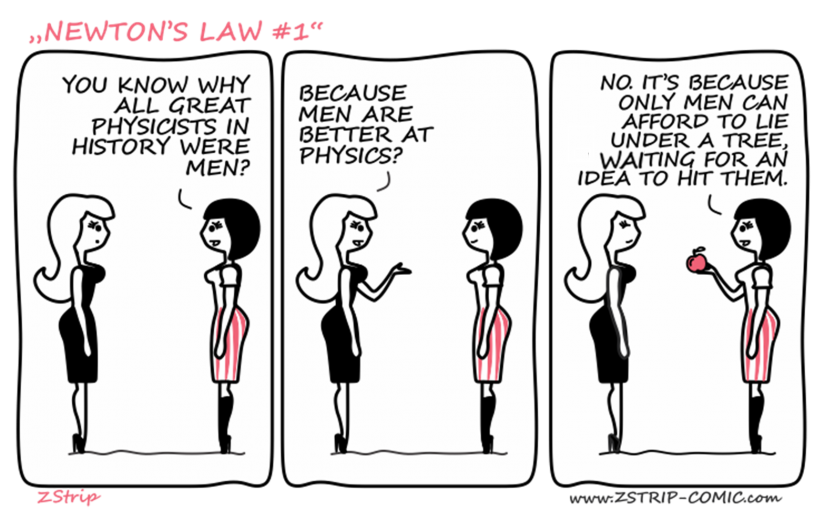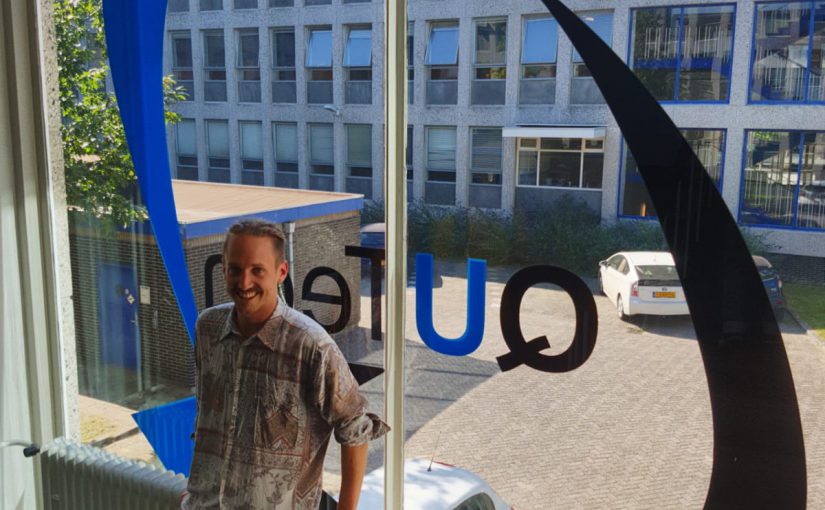19.09.2019by Floor van Riggelen
Counting women in physics

by Floor van Riggelen
Take a close look at this famous picture. These are the people who attended the fifth Solvay International Conference (1927), where the leading physicists of that time discuss the newly formulated quantum theory. What stands out to me is that this is quite a homogeneous group: 28 white (including Jewish), middle aged guys, plus Marie Curie. Of course, these were different times. Comparing this to QuTech in Delft, the place where I work, (an example of a physics research environment in general) there are some improvements when it comes to diversity. Currently 23% of the QuTech employees are non-European and 17% percent are female, according to a recent official review [1]. However, a quick count on the QuTech webpage will tell you that if you only look at scientists and technical staff [2], this percentage drops to about 10%. At QuTech there are still several scientists who are the only woman in their research group. Looking at it in this way, it seems that not much has changed in almost 100 years of quantum physics.

Participants of the 1927 Solvay conference.
Fortunately, we know that is not true. With the emancipation of women throughout society, it also became much more common for women to study and work at the university. The general attitude has changed significantly (although there are still some painful exceptions [3]); most people don’t believe anymore that women are by definition less suited to work in science than men. Still, physics (and technical studies in general) are lacking behind in the number of women, as shown clearly in the statistics of the American Institute of Physics [4]. Seeing the live version of this statistic around me every day, I keep wondering how it is possible that I don’t have more female colleagues.

Reasons why women in are outnumbered in our field are numerous and much more subtle than intentional discrimination by men against women. There are studies that show girls are less likely to choose advanced science and math subjects in high school, even though boys and girls show the same amount of talent for math early on in their educations. One of the explanations is the unconscious assumption of students and teachers alike that for math and physics you need innate skills, where girls in general count more on their ability to work hard. Another reason is that, when you think of a scientist, you most probably think of a man. And to consider studying sciences as reasonable option, it really helps to have role models, which, for girls in science, are few. These are just two examples of studies of a large research field [5]. My impression is that most reasons are related to an unconscious bias, both in the heads of male and female students and teachers, which results in the fact that girls are more likely to choose a different field of study and, consequently, a different career.
However, choosing to study science is (just) the first hurdle. As illustrated by a research from Yale in 2012, it is harder for women to get appreciation for their talent and achievements [6]. In this study, a resume of a potential lab manager, either labeled John or Jane, was shown to university faculty members (n = 127, both male and female). The applicant called John was assessed to be more competent and hirable than (the identical) Jane. Moreover, the faculty members (again, to emphasize, both male and female!) would offer John a higher starting salary and more career mentoring. Furthermore, a study published in Nature shows that articles with a female first author get 10% fewer citations than what would be expected if the papers would have been written by a man with the same non-gender-specific properties [7].
These reasons why women are underrepresented in science are in itself a strong argument why we need to take measures to change this. People with the same talent should get the same opportunities and support, and people with the same merits should get the same appreciation, regardless of their gender. There are more reasons though. First of all, boys and girls show similar talent for subjects such as math and physics. Clearly, by not stimulating girls enough to pursue an education in physics, our research field is missing out on a lot of talent. Secondly, increasing the diversity can change the dynamics in the workplace. Personally, I prefer a work environment where I have at least a few female colleagues. A male-dominated group has a certain dynamic and it is easier to find your way if you are not the only one (although it is very much group-dependent and not at all impossible). In discussions that we had with female scientists at QuTech, one of the conclusions was that there probably is a threshold for attracting women, meaning that it is even harder to find women who want to work in a research group if they will be the only woman in the group. Thirdly, diversity in itself is something worth aiming for. Studies performed in industry suggest that diverse teams are more creative and are faster in problem solving [8,9]. Diversity goes beyond having a gender-balanced team, it is about including people with different backgrounds and different ways of thinking. This would be the result of including people of different ethnicities, gender and age. It makes sense if you think about it: different people come up with different kinds of ideas. Moreover, to make sure everyone can perform according to their potential, they should feel at home in the working place. If I take again my own working place as an example, it is clear that improving the gender balance would be a very significant part of increasing diversity at QuTech.

My research group at QuTech.
This is also one of the recommendations in the midterm review of QuTech, phrasing it in the following way: “as QuTech aims to be better than a world leader in all of its undertakings, it encourages the institute to aim high and exhaust all possibilities in order to attract female talent”. “All possibilities” include in my view both trying to change the image that people have of science as a men’s world and counteracting (unintentional) discrimination. Examples of changing the image are having programs in high schools to encourage girls to choose beta courses [10], trying to change the image in the media by asking female scientists as spokespersons and making sure that girls studying physics have female role models to inspire them to pursue a career in science. Changing the image that people have of a typical scientist would help to prevent unconscious bias. For counteracting discrimination, we could make the first few steps of the application process anonymous, actively headhunt for female talent, follow unconscious bias workshops with faculty staff or even follow the example of the TU Eindhoven. The rector of the TU/e recently announced that for the coming half year all the job openings for permanent staff will be open for female applicants only [11]. If after six months no suitable female scientist is found to fill the position, male scientists can apply as well. For all the positions that open up, the goal is to fill 50% of the assistant professorships and 35% of the associate and full professorships with women. It is a drastic measure, to discriminate in favor of women, but maybe that is what is needed to balance out the unintended discrimination shown for example in the Yale study. The main argument from TU/e was: with the measures that were taken so far, progression was not fast enough.
All in all, this is a complicated problem which cannot be solved overnight. But this is not at all an excuse to do nothing about it. TU Delft is setting up a Diversity and Inclusion team to develop policies and, closer to home, Charlotte van Hees is addressing this issue for QuTech. Lately, there have been lunches with the female scientists to exchange experiences and come up with ideas to attract and retain women for QuTech. However, I hope I have argued convincingly in this blog that increasing diversity is something we can all benefit from. So, please, if you have an opinion on how we should tackle this, at QuTech or more in general, let it be heard!
Footnotes and References
[1] Research Review QuTech (2019)
[2] To make it absolutely clear: this means in no way that I don’t appreciate the contribution of non-technical support staff to QuTech, on the contrary.
[3] M. Banks, Thousands of physicists sign letter condemning ‘disgraceful’ Alessandro Strumia gender talk, PhysicsWorld (2018)
[4] Porter, A.M. and Ivie, R., Women in Physics and Astronomy, 2019 AIP (2019)
[5] Women in STEM fields, Wikipedia
[6] Moss-Racusin, C.A. et al., Science faculty’s subtle gender biases favor male students, PNAS (2012)
[7] Caplar, N. et al., Quantitative evaluation of gender bias in astronomical publications from citation counts, Nature Astronomy 1 (2017)
[8] Barta, T. et al., Is there a payoff from top-team diversity?, McKinsey&Company
[9] Science benefits from diversity, Nature, 555 (2018)
[10] Beta sciences are, in the Netherlands, a general term for sciences as mathematics, physics, chemistry and biology, close to STEM.
[11] TU/e vacancies for academic staff exclusively for women for the time being, website TU Eindhoven (2019)
 Floor is a PhD student in Menno Veldhorst’s group. She loves research, to try to understand spin qubits and the world around her. In her spare time she likes reading, making music and creating things by sewing, drawing or knitting.
Floor is a PhD student in Menno Veldhorst’s group. She loves research, to try to understand spin qubits and the world around her. In her spare time she likes reading, making music and creating things by sewing, drawing or knitting.

